This article first appeared in Overland Journal, Summer 2019. (Republished due to popular demand.)
As I tightened the last bolt of the awning’s mounting bracket, I smiled, envisioning how the scene would unfold. Soon I would be sitting on some remote sandy beach, the waves lapping on the shore while I sipped a cold drink beneath the unfurled shade. My travel companion would congratulate me on my wise investment, and we would spend the afternoon relaxing in the breeze while other poor souls baked in the tropical sun. After a few hours of relaxation, I would fold the awning away in moments, leaving it neatly packed until it was needed once more. Things did not go according to plan.
What actually occurred was a mixture of bad choices, unsavoury language, and what appeared to be a scene from the movie Twister. In other words, comedic gold for any lucky onlookers. The mild breeze I had so lovingly envisioned turned the awning into a sail, attempting to rip it from my grip at every turn. Support poles lifted and fell over with each gust, and blasts of hot air threw sand into my face as I tried desperately to tie the churning beast down. In the end, I managed it, only to wrestle the awning back into its bag a few hours later.
Thankfully, I’ve learned a lot since that first experience. Not only about how and when to set up an awning, but also about selecting the right one for the job in the first place. Here are a few factors to consider before making your purchase.
QUALITY
Quality is always king in the backcountry. Whether you’re talking about tires, tents, winches, or awnings, a cheap piece of gear will cause you more frustration, hardship, and possibly danger than it’s worth. Key points of quality for awnings are going to be the bag, zippers, poles, and hinges. If any of these components are poorly made, it will create one headache after another in the field—we know this from experience.
Complexity
Keep it simple, especially when it comes to awnings. The more complex the product is, the more time it will take to set up and stow, and the less you will use it. I can’t tell you how often I’ve had conversations with people about their builds only to hear they don’t use some aspect of it because it takes too long to assemble. Awnings are usually the chief offenders in these cases.
Size and Weight
Most of you are well aware that heavy roof loads are a bad thing, and that needs to factor into awning selection. A heavy awning will not only affect performance but also take up part of your overall weight capacity for the roof. If you plan on also adding a rooftop tent, this could become an issue.
Size, although less critical than weight, still plays into the equation. Larger awnings create more wind noise and drag, reducing fuel economy and increasing annoyance on the highway. They are also more likely to incur damage on tight trails.
270- or 180-Degree Coverage Profile
Although many people assume that 270 awnings are superior to 180s due to their coverage profile, there are advantages and disadvantages to both varieties. First, let me clarify the difference between the two. If you look at a 270 awning from above, it completes three-quarters of a 360-degree circle, representing 270 degrees of the radius. Thus, it’s called a 270. A traditional awning, on the other hand, makes up 180 degrees of that arc, although admittedly it’s harder to envision since these awnings are rectangular for ease of use, maximum coverage, and affordable production.
While the 180 does provide less square footage, they are also lighter, quite a bit cheaper, and in many cases, easier to set up and break down than their larger counterparts. They usually present a lower profile on the vehicle, and can be deployed in more confined spaces. The 270s provide more comprehensive coverage, spanning to the side and rear cargo section of the vehicle, making it much easier to cook food, relax, and spread out while escaping the sun, rain, or snow. Freestanding 270 awnings are becoming increasingly common, and they narrow the margins of setup time between the 180 and 270 versions significantly.
Testing and Considerations
After owning and using a myriad of awnings in all sorts of conditions, we knew that there would need to be a variety of considerations for readers to receive a complete picture of these products. Obvious factors like quality, coverage, wind resistance and durability needed to be taken into account, but there was also setup and breakdown time, water drainage patterns, and the noise levels generated by components rattling and flapping around to consider. In the end, we evaluated each awning by 22 different criteria to see how they stacked up against one another.
For standardisation, the awnings were all installed on the same Front Runner roof rack on top of Overland Journal’s Mercedes G-Class. We chose a Front Runner rack for its abundant mounting options, but also due to the company’s lack of a 270 awning in their product line, thus eliminating any possible bias. Mounting brackets and hardware were either supplied by the manufacturer, or by Front Runner when recommended as best practice.
Our analysis was comprised of multiple stages, starting with an initial inspection of components and features. Once completed, we set the awnings up and sprayed them with water to examine their ability to handle rain. The fabric and seams were inspected for signs of leaks, and any areas prone to pooling were filled to their greatest capacity to see if there was a risk of collapse.




Following the water evaluation, we took the awnings out on city roads and highways to determine how much noise they produced during daily driving. Flapping fabric, jangling zippers, clanking internal components, and whistling due to size or shape were all considerations. Noise evaluations were expanded further by driving down a series of heavily corrugated dirt roads to our shooting location.


Once we reached this location, each awning’s setup and breakdown times were recorded in freestanding and supported positions. We chose to exclude the timing of guylines, as too many external factors affect the outcome: rocks, hard ground, stake shape, etcetera.
Wind resistance and noise in camp were tested through two methods: actual wind blowing through the site, and manually induced shaking and deflection on each section of the product. Measurements of deflection were excluded as a component of the test, as we thought they were inaccurate indicators of strength. As you’ll find in aircraft wings and even in trees, oftentimes the structure that bends can endure more abuse than the ones which hold firm.
SIMPLICITY
The more complex the product is, the more time it will take to set up and stow, and the less you will use it.
COVERAGE PROFILE COMPARISON
ALU-CAB, SHADOW AWN
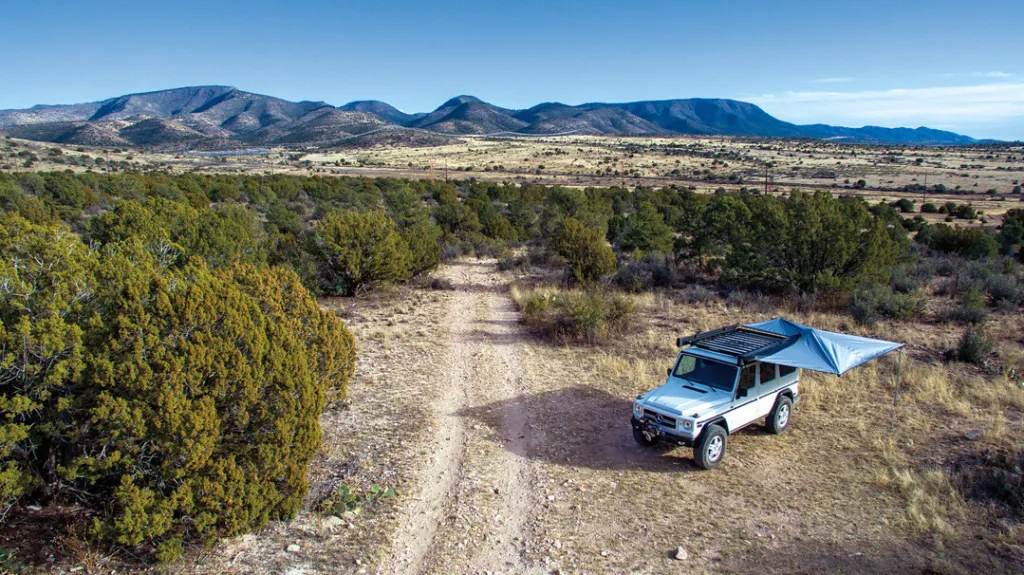

DARCHE, ECLIPSE 270


RHINO RACK, BATWING


BUNDUTEC, BUNDU L


EEZI-AWN, BAT 270


It can sometimes be difficult to appreciate the nuances in coverage between various awnings, but when viewed from above the differences become clear. The Alu-Cab, Eezi-Awn, and Rhino-Rack share a common folding pattern that utilises a single set of armatures making them quick to stow and deploy, but also providing less protection from the sun or rain. The Darche and BunduTec, on the other hand, gain a considerable increase in square footage by using a second armature which folds forward toward the hood. The cost is that they require an additional step during setup and breakdown, adding complexity.
ALU-CAB
Shadow Awn | Editor’s Choice
Easy setup, thoughtful design, and flawless execution make the Shadow Awn a clear winner in the pack.
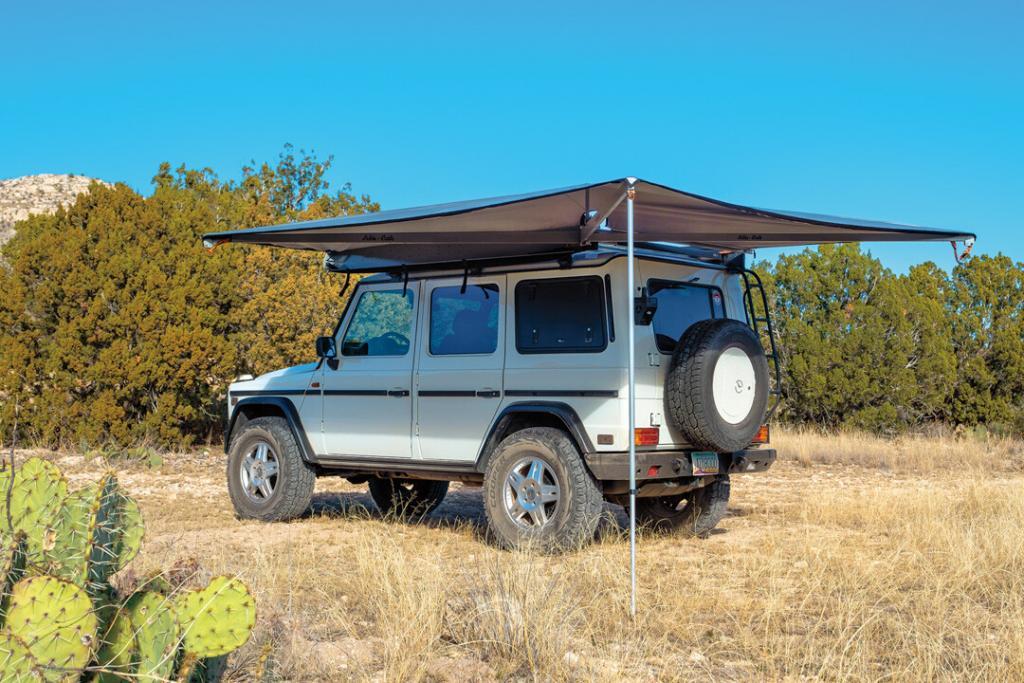
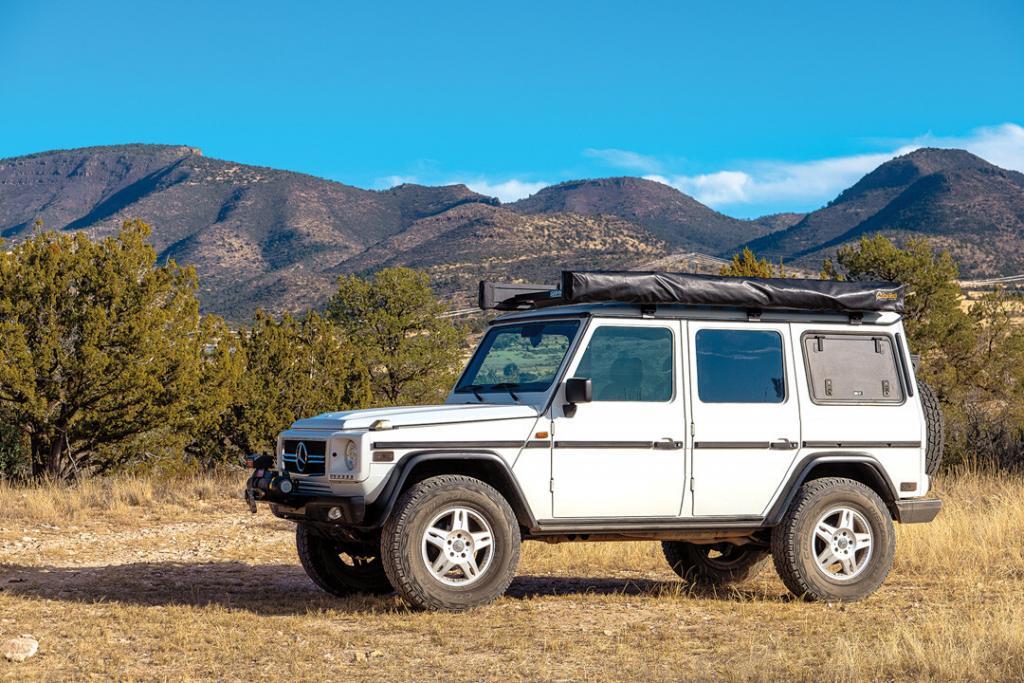
PROS
Excellent fit and finish
Sturdy when freestanding
Perfect bag and zipper combination
Quick to deploy and store
Feature-rich awning material
CONS
Expensive
Second smallest coverage



Alu-Cab founded their business on building custom trucks and specialty products for overlanders in South Africa. Their “if you dream it, we can build it” business concept led to projects ranging from simple drawer systems to stunning Unimog builds, but as the overland market grew they wanted to expand their business with it. To reach the masses, they unveiled a series of standardised products that could be shipped all over the world, one of which was the Shadow Awn.
Installation of this model split the pack on time and difficulty. Although mounting points are pre-drilled, it requires you to punch two holes in the back of the bag to match the brackets. They also recommend riveting the strap to the vehicle’s roof rack, hardshell tent, or body which we decided to forgo for this test.
The UV-stabilised cover is ideally sized, just big enough for an easy breakdown but not so big as to flap in the wind. Its heavy-duty YKK zippers are amply sized for the task at hand and feel stout yet smooth during operation. This small detail is a big win, as undersized zippers are usually the first failure point on soft goods.
South African manufacturers have long carried a reputation for good design with poor execution, yet this wasn’t even remotely the case with the Alu-Cab. The armatures, hinges, and supporting components are not only well thought out but produced with exquisite attention to detail. There were no unfinished edges or loose metal shavings, the welds and paint were flawless, and everything felt durable. It may be a mass-produced product, but it reflects the quality you’d expect from Alu-Cab’s custom pieces.
The Shadow Awn is also packed with small additions that make a big difference in usability and convenience, like a mesh stake bag riveted into the aluminum casing, so you never lose it, and guylines that store inside the armatures for quick access. One of our favourite features is the folding leg that deploys to form a high point in the fabric, preventing rain from accumulating during a storm. Even the fabric itself is innovative, a 270 GSM TenCate aluminised acrylic canvas which reflects the sun’s rays and reduces temperatures beneath the awning.
Deploying and stowing the Shadow Awn was a breeze, producing the second quickest setup time in the test, as well as the fastest breakdown time by a wide margin. Coverage was adequate, but at 107 square feet, it was the second smallest in the test. That being said, it was the most stable of any awning in the evaluation thanks to its robust arms and heavy-duty joints. Even in its freestanding mode, the Shadow Awn showed little deflection in the wind, which means you’ll be able to deploy it unsupported more often. Should conditions necessitate it, a single integrated support leg can be dropped down in a matter of seconds to brace the awning against the wind.
Noise was minimal on the road, thanks to the tidy profile of the bag, and the shakedown test revealed no notable rattles or annoying sounds in camp. During our rain evaluation, the high point we mentioned earlier helped the Shadow Awn to shed water quickly, preventing any accumulation on the fabric.
Of course, you get what you pay for, and you will certainly be paying for the Shadow Awn’s quality. At €1,440 it is tied as the most expensive awning in the test, but if you have the means, I would highly recommend it.
€1,440 | ALU-CAB.COM | GENESIS-IMPORT.DE
BUNDUTEC
Bundu L
The Bundu L packs big coverage and fantastic features in a lightweight package.


PROS
Extensive coverage
Ripstop silver-backed fabric
Heavy-duty construction
Lightweight
Freestanding
CONS
Fit and finish are poor
Large profile when stored
Single support pole stored separately
Tears in material
Most difficult installation
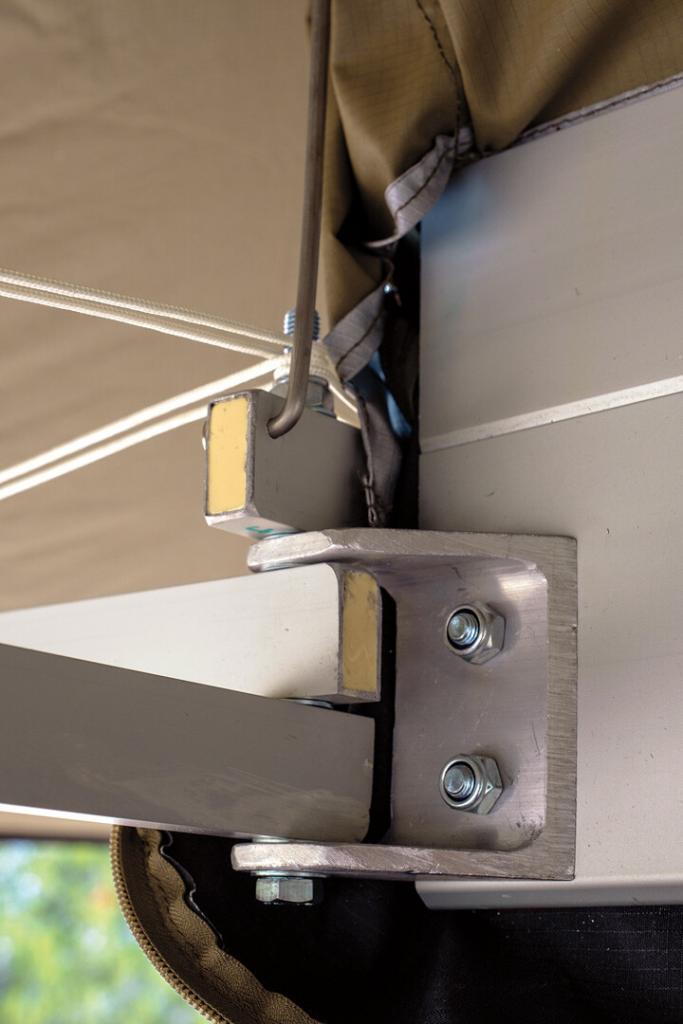
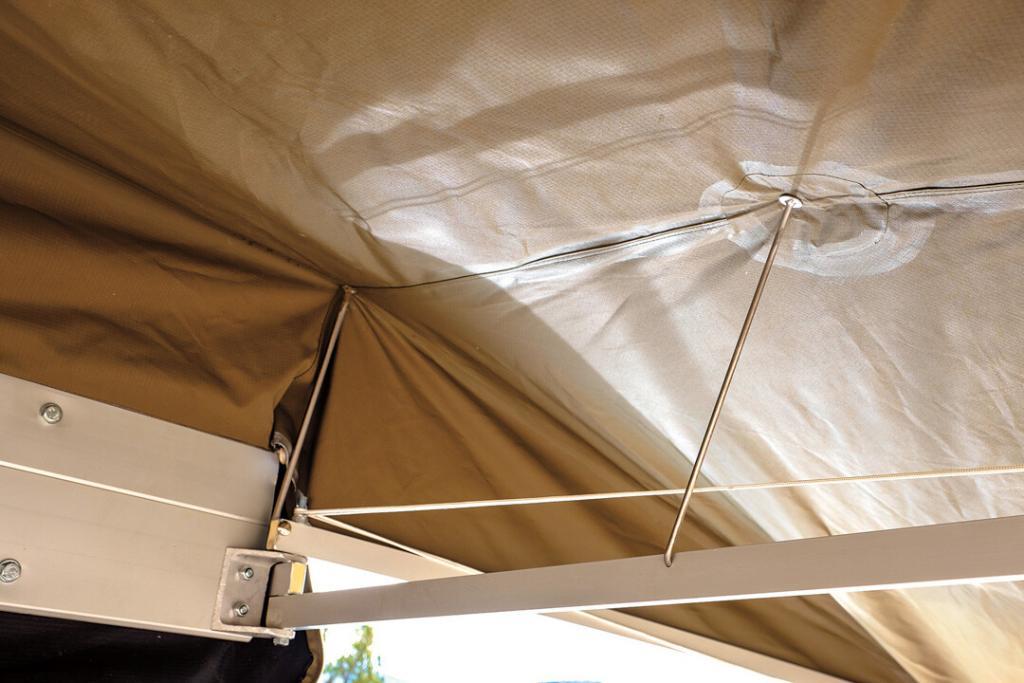

BunduTec has been making innovative off-pavement products like electric-powered rooftop tents for years in the Australian market, but they’ve only recently made their way to North America. After testing their BunduTop tent, we were excited to try out their medium-sized 270 awning.
The Bundu L was designed to fit as many applications as possible by using generic hardware and brackets, which has its advantages, but also made the BunduTec the most difficult to install. The process required a total of 16 holes to be drilled without guidance or templates: four in each of the two T brackets, four in the roof rack, and four in the awning itself. You also need to punch four holes in the bag, but that seems like a cakewalk after the drilling. There are plenty of chances to make a mistake, especially given the awkward size of this awning, so unless you are experienced and have a second set of hands to assist you, we recommend professional installation.
Once the Bundu is in place, it works quite well. The awning deploys and stores easily while utilising one of the quickest and easiest strap systems we tested. Setup and breakdown times are admittedly the second longest in the test, not due to difficulty, but rather the nature of the design. While the majority of 270 awnings feature a single hinge and set of armatures, the BunduTec has two, enabling it to stretch further toward the front of the vehicle than would otherwise be possible. This requires slightly more time to walk back and deploy the second wing, but the reward is a massive 158.2 square feet of coverage, the largest in the test. Unfortunately, it also presents the largest profile of any awning when stored, which comes with all the downsides we mentioned in our considerations section.
Still, BunduTec has clearly thought out their design, as the L was very stable in the wind and seemed up to the task of enduring extensive abuse in the field. It was also surprisingly quiet under heavy shaking, so there will be no concern of noise keeping you up at night.
Rain resistance was outstanding, thanks to two integrated self-raising arms which create high points in the fabric, allowing water to flow off the awning instead of pooling. This is similar to Alu-Cab’s system, but the BunduTec’s legs set up automatically without stressing the fabric nearly as much. The L was the only other awning to feature a reflective material. Their 310 GSM polyester acrylic canvas is coated with a silver resin backing, which gives it similar heat reflective properties to the Alu-Cab.
Sadly, the fabric had a tear in it upon opening the awning for the first time. These things happen, but it felt more like a pattern, as metal shavings were prominent in the bag, edges were ground smooth but looked rough, and the instructions were laughably inadequate. The worst offender of fit and finish were the mounting brackets, which seemed thrown together, weren’t the same size, and were chipped and rusted after just a few weeks of use.
$1,499 | bundutec.co.za
DARCHE
Eclipse 270
Quality components, solid attention to detail, and abundant coverage will make you fall in love with the Eclipse.


PROS
Good fit and finish
Large footprint
Affordable
Easy to install
Freestanding
CONS
Cover is far too tight
Zipper feels weak
Support poles can be difficult

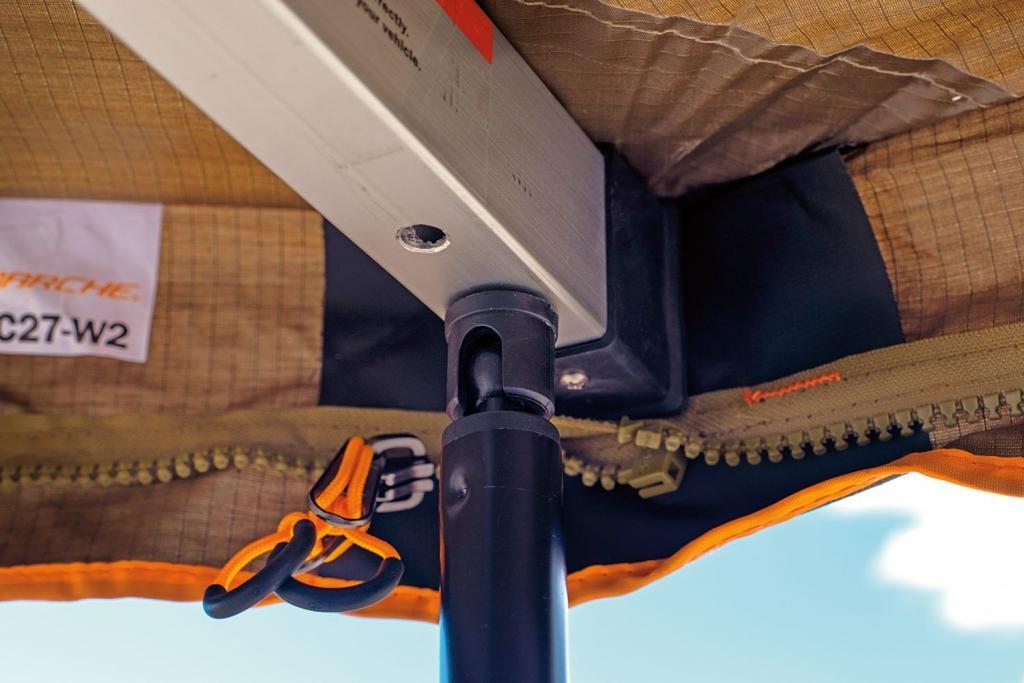

The Darche awning was the wild card in our test. We had virtually no experience with the product, or indeed the brand as a whole.
Like the BunduTec, the Darche was also designed to fit a wide variety of applications, but their installation process didn’t require hours of work and pinpoint accuracy to complete. The universal mounting brackets were expertly crafted with clean welds and a solid powder coat, and incorporated details like a slight rise near the joint to accommodate the edge of your roof rack. The cover even had convenient Velcro openings through which to slide the hardware into the track. These touches showed how much thought went into development.
The bag is made from laminated 600 GSM PVC which looked and felt great. However, it was apparent after the first attempt to stow the awning that the cover lacked sufficient space to accommodate the bulk of the product for storage. Even when folded away precisely, the cover was too tight, placing a significant strain on the self-repairing zipper, which in itself was too small. This combination gave the Eclipse the longest stow time in the test. Fortunately, Darche states that they plan to add additional material to upcoming models, so this problem will hopefully become a thing of the past.
Quality on the rest of the awning was very good though. The armatures were well made and had smooth, finished edges, zippers were paired with handy rubberised pull tabs, and the 260 GSM poly cotton ripstop canvas looked and performed well.
Like the BunduTec, the Eclipse uses a dual hinge construction, which gives it the second largest coverage area, a full 123 square feet of shade. It can be deployed in fair weather without support but has three built-in legs for mild wind, and an additional three stored in the vehicle in case the weather gets crazy. These legs were fairly easy to use, but I didn’t like having to bend down to twist the bottom to stow them. That adds time to setup and breakdown and will be difficult for anyone with back issues.
Wind noise was minimal on the road, and the awning made almost no noise during our shaking tests. Rain resistance was fair, with no signs of leaks in the fabric or seams. However, the poles must be tightened thoroughly when set up, or any accumulating water will cause them to slip down to a shorter position, slackening the guylines and removing the product’s support.
Given its quality, coverage, and attention to detail, we were surprised to find that the Eclipse was the second-most affordable awning in the test, and the most affordable model capable of freestanding. At a retail price of €1.200 it represents a true value to consumers, and nearly won our Value Award for all of its positive attributes. The impact of the tight cover was just too big of an issue to overlook though, and ultimately cost the Eclipse the title, though just barely.
€1.200 | darche.com.au | xp-edition.eu
EEZI-AWN
BAT 270
If you’re looking for a lightweight awning with an outstanding fit and finish, the Bat could be a perfect choice.


PROS
Excellent fit and finish
Fastest set-up time
Lightest overall
Freestanding
Easy installation
CONS
Rattles on road and in camp
Accumulates rain



Eezi-Awn has been producing high-quality overland gear for more than 36 years. Their approach of using proven designs and materials has given them loyal customers the world over, but with recent advances in awning and tent technology, we were curious to see how the Bat would stack up.
Installation was among the easiest in the test thanks to Eezi-Awn’s integrated rear track system and Front Runner’s specific brackets, which only require basic hand tools to bolt on in a matter of minutes. Once installed, we were able to open the awning up and get our first good look at the quality. As we had suspected, the fit and finish of the components was superb, with a tidy and professional presentation on every corner, edge, and surface. The fabric had no signs of wear or tear, and everything functioned properly.
Deploying the awning unsupported from start to finish can only be described as effortless, and took just 47 seconds, the quickest recorded time of any product in the test. This surprisingly quick deployment is a huge bonus for the Bat, but you won’t be able to take advantage of it very often, as the anodised aluminum armatures aren’t up to the task of enduring real winds without the support legs deployed. Thankfully, that’s not a huge issue during setup, as dropping them only took an additional 24 seconds. Stowing the legs is where the time really added up, as each needs to be slotted up inside the aluminum armature, slid into a metal hoop, and then tightened with an integrated knob to secure them from sliding. This gave the Bat a breakdown time even longer than the BunduTec, an awning which features two hinges and nearly double the coverage.
Speaking of coverage, the Bat has the least of these five awnings, a mere 88.2 square feet to be exact. It does make up for this with a slim profile on the vehicle, and a total weight of just 46 pounds, the lightest in the evaluation. This makes it ideal for anyone concerned about total weight on their roof racks.
During our rain test, the 260 GSM canvas proved to be entirely waterproof as Eezi-Awn claims. However, the lack of any high point in the fabric and the inability to slope the awning toward the ground resulted in water accumulating along the outer edges of the product. Eventually, a large enough pool would form that water could spill over the edge, but there was no way to eliminate the pooling altogether.
During our road test, we found that the Bat had very little wind noise, but that the legs could rattle in the bag causing a clanking sound on bumps or corrugations. A similar noise was also apparent during our shakedown tests in camp, which could be an issue during late-night windstorms.
$1,300 | eezi-awn.com
RHINO-RACK
Batwing | VALUE AWARD
Innovative features, a low price point, and painless setup and breakdown make the Batwing a favourite among the group.


PROS
Easy to set up and break down
Lightweight
Bag and zipper paired perfectly
Well-thought-out design
Easy installation
Nice fit and finish
CONS
Not self-supporting


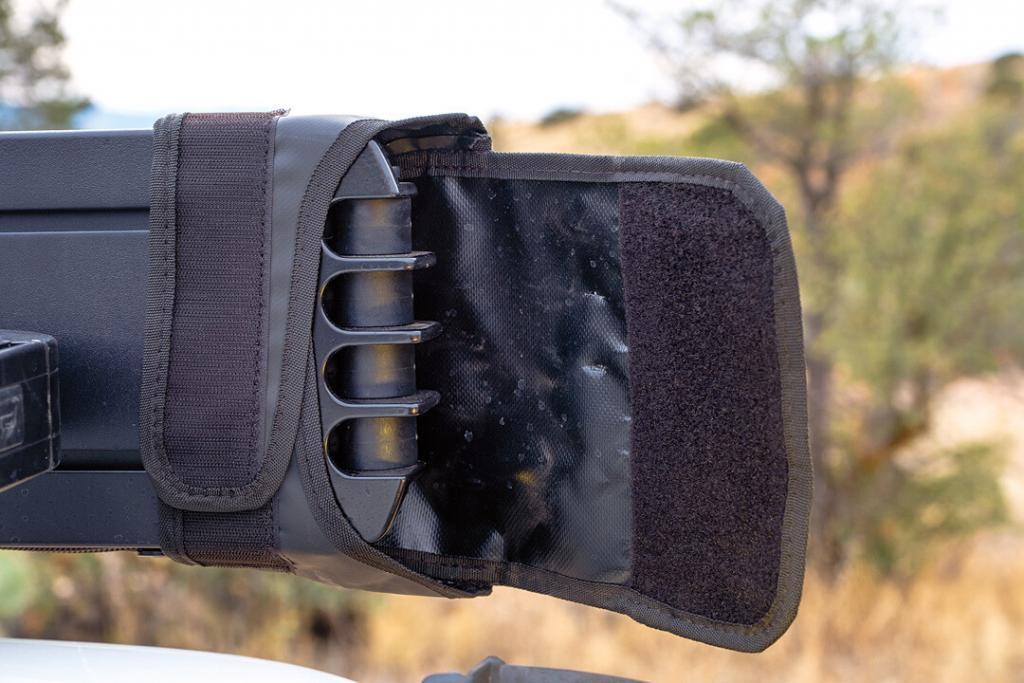
On the home page of Rhino-Rack’s website, you’ll find a brief paragraph introducing you to their company, where they use only two terms to describe their products: durable, and easy to use. This seems only fitting as those are traits that embody their Batwing awning.
Let me start by saying the Batwing is the most affordable awning in the test, and not by a narrow margin either. At €686, it is half the price of the Alu-Cab and BunduTec, and 35 percent cheaper than its nearest competitor, the Darche. Despite this enormous price gap, it managed to impress us from the very beginning.
Installation was one of the easiest in the test; it took only a matter of minutes to attach the brackets and tighten the bolts through the integrated track. The awning’s heavy-duty PVC bag was sized perfectly to the product while the generously sized zipper operated smoothly, leaving no question of whether it was up to the task of closing the cover. The combination made the product one of the easiest awnings to store overall, and one of the more enjoyable to use.
Fit and finish were top-notch, with no signs of metal shavings or wear and tear from shipping or production. The design was creative and thoughtful, with small features you didn’t even know you wanted until you saw them. For example, when stowing the awning, a small array of magnets hold the arms against the rear of the awning body. This allows you to use both hands to fold the fabric up and connect the straps, instead of fighting to keep everything together with one hand and folding with the other. The zipper at the front of the awning is also covered by a secondary flap of PVC, which prevents it from accumulating dust, bugs, and mud on the road. Then there are the support poles, which use a twist grip to tighten and loosen, but on the top half of the pole instead of the bottom, so you don’t have to bend down to adjust height. These support legs can also be folded away at full length, so you don’t have to make big adjustments each time you set up and break down the awning. This feature helped make the Batwing one of the easiest products to use, and the quickest to deploy with supports. It’s two seconds faster even than the Alu-Cab, which only uses a single support pole to the Rhino-Rack’s four. It makes sense that they put so much effort into making the legs quick to deploy, as the Batwing is the only awning in the test that cannot be used unsupported.
Noise levels on the road were minimal, thanks to a slim profile, and there were no discernible rattles during wind testing or the shakedown. Weight is the second lowest in the test, just a pound heavier than Eezi-Awn’s Bat at 47 pounds.
Performance in the rain was very good, as the Batwing’s ability to droop allowed water to run off the fabric easily. Even when the water was forced to accumulate, the 210D ripstop canvas showed no signs of leaking. In fact, it was the only awning in the test that couldn’t be made to leak through either the seams or fabric. The canvas is also mould resistant, tested to a UV50+ rating, and endorsed by Cancer Council Australia with a portion of each sale going toward cancer research.
€686 | rhinorack.com
CONCLUSIONS
Just five years ago, the selection of 270 awnings available in North America was scant, yet their popularity soon spurred a manufacturing race that led to more options and innovations than ever before. This rapid expansion has made it hard to separate the wheat from the chaff. Our evaluation revealed that unlike many products we review, the price and features of 270 awnings didn’t always correlate with quality or ease of use. Small nuances like zipper choice or bag size could make large impacts on practicality, levelling the playing field between the most affordable and most expensive awnings in the test.
I had originally suspected that selecting an Editor’s Choice Award would be the most difficult part of the evaluation; it turns out that the Value Award posed a far greater challenge. The competition for that title was intense and came down to just two options: the Darche Eclipse and the Rhino-Rack Batwing. Each provides tremendous bang for your buck while boasting different strengths and weaknesses.
The Darche is an undeniable value for anyone looking for a 270 awning. The fit and finish are quite good, the materials are of high quality, and the armatures are solid, enabling it to be freestanding even in light wind. It was quiet, looked great on the vehicle, and thanks to the dual hinge design had the second largest footprint in the test. Unfortunately, there were just a few issues that tilted the award toward the Batwing, the most significant of which was the cover and zipper combo. Despite watching tutorials and following directions precisely we had a 50/50 shot at stowing the Darche inside the bag on any attempt. Even when successful, we found ourselves struggling with the zipper. Had the new larger cover been installed this may have been a very different scenario, but without testing one firsthand, we couldn’t give the title to the Darche.
Instead, the Value Award was given to the Batwing, a deserving winner. Although it was the only awning in our test not designed to be freestanding, the Batwing was so easy to set up and break down that it didn’t bother us. When you look at the setup/breakdown times, the Batwing only took two seconds longer to deploy with all four of its support legs than the Darche took without any, and was faster to store than all but the Alu-Cab. This ease of use extended through every aspect of the awning—from the magnets which held the armatures in place, to the zipper cover which prevents dust from clogging the teeth, to the poles which can be stowed at full length and adjusted without bending down. Even the seams of the UV-rated fabric featured some of the best seals in the test. The Batwing’s only real downside was its lack of wind resistance, requiring the awning to be tied down in anything more than a light breeze. It’s an inconvenience to be sure, but at half the price of our Editor’s Choice, it is an inconvenience most can readily accept.
The Editor’s Choice Award is given to the product that we would choose regardless of price. While other awnings packed almost as much innovation, ease of use, or quality into their designs, none of them carried all three like the Alu-Cab Shadow Awn.
Everything about this awning is thoughtfully designed, developed from years of testing and experience in the field. The bag and zipper are perfectly sized to minimise the awning’s profile on the side of the vehicle, while still providing enough space to close easily during breakdown. The armatures were the sturdiest in our test, enabling the Shadow Awn to deploy without support in a greater variety of situations, and the single leg and integrated guyline design was so simple that it hardly required a second thought. I loved the TenCate aluminised acrylic fabric for reducing heat almost as much as the integrated leg which created a high point to eliminate water accumulation during rainstorms.
The best part of the Shadow Awn though wasn’t any individual factor, but rather the overall feeling of using the product. It didn’t matter what the conditions were outside; using the Alu-Cab was quick, easy, and enjoyable. It is an awning that I wouldn’t think twice about setting up for a quick lunch stop or coffee break, and that is the real test of a product. After all, if it’s too time-consuming to put to good use, why have it?
Small nuances like zipper choice or bag size could make large impacts on practicality, levelling the playing field between the most affordable and most expensive awnings in the test.
While the Alu-Cab and Rhino-Rack awnings took home our Editor’s Choice and Value awards, there are no bad choices in this review. Pick the right one for you, and then get out and enjoy it.







